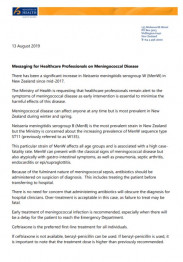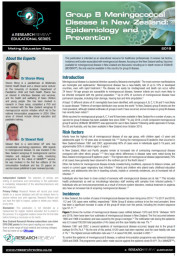|
Resources |
|
 |
Messaging for healthcare professionals on meningococcal disease (August 2019)
Read more: Messaging for healthcare professionals on meningococcal disease(external link). |
 |
The following information is taken from a research review educational series.
|
Low or no data? Visit zero.govt.nz, scroll down the page then click on our logo to return to our site and browse for free.
Meningitis for healthcare providers
Key points about meningitis
- This page contains information about meningitis for healthcare providers.
- Find information on clinical updates, clinical resources and CPD.

Meningitis resources for healthcare professional(external link)s CDC, US, 2019
Meningitis(external link) Starship Clinical Guidelines, NZ, 2018
Management of bacterial meningitis in children and young people(external link) Meningitis Research Foundation, UK
Early management of suspected bacterial meningitis and meningococcal sepsis in immunocompetent adults(external link) Meningitis Research Foundation, UK
Management of bacterial meningitis in infants under three months of age(external link) Meningitis Research Foundation, UK
Meningococcal disease – information for general practitioners and emergency departments(external link) Ministry of Health, NZ, 2018
Meningococcal – information for health professionals(external link) Health New Zealand | Te Whatu Ora
Meningococcal disease – always consider in a patient with flu-like illness(external link) BPAC, NZ, 2014
eTool – improving the recognition, diagnosis and management of bacterial meningitis in young infants(external link) Meningitis Research Foundation, UK
Webinars
Video: PHARMAC seminar: Common infections, 4: Meningitis, acne & cellulitis by Dr Arlo Upton and Prof. Bruce Arroll
(PHARMAC Seminar, NZ, 2018)
Credits: Healthify editorial team. Healthify is brought to you by Health Navigator Charitable Trust.
Page last updated:


